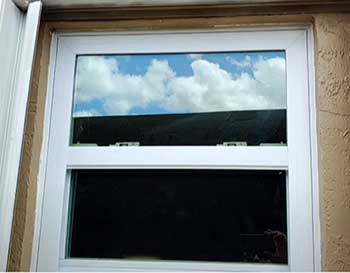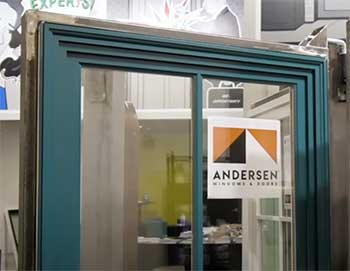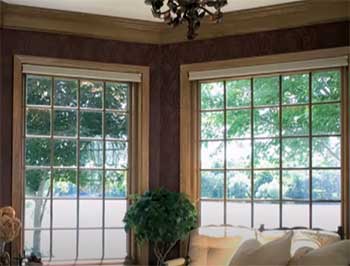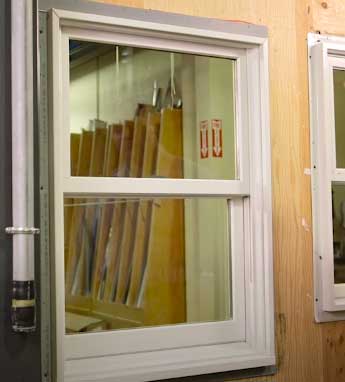Windows are one of the most important features of any home. Not only do they allow natural light to flow in, they also serve as a barrier against outdoor elements like weather, noise, and dust.
When it comes time to replace old or worn out windows, homeowners must decide which brand to go with. Two of the most popular window manufacturers are American Craftsman and Andersen. But which one is better?
In this comprehensive guide, we’ll compare American Craftsman and Andersen replacement windows to help you determine the right option for your home improvement project. We’ll look at key factors like materials, energy efficiency, cost, warranties, styles, and more.
By the end, you’ll understand the main pros and cons of each brand so you can make an informed decision.
A Brief Comparison Table
| Feature | American Craftsman | Andersen |
| Frame Material | Pultruded fiberglass | Fibrex (vinyl/wood composite) |
| Glazing | Dual pane silicone spaced (triple pane upgrade) | Dual pane Fibrex spacer (triple pane on some models) |
| Energy Efficiency | Meet or exceed ENERGY STAR for most models | Exceed ENERGY STAR requirements |
| Cost | 25-40% less than Andersen | 25-50% more than American Craftsman |
| Warranty | Limited lifetime on frame and glass | 10 years on frame, 20 years on glass |
| Styles | All essential operating and stationary styles plus garden windows | More limited operating styles but unique circle windows |
| Customization | Good glass, color, and grid options | Excellent art glass textures and unlimited sizing |
| Installation | Through independent authorized dealers | Certified installer network trained by Andersen |
Overview of American Craftsman and Andersen
First, let’s start with a quick rundown on both brands.

American Craftsman is owned by Pella Corporation, a large window and door manufacturer that has been around since 1925.
Many of their windows feature fiberglass construction for durability and low maintenance.
They offer a range of products from basic builder-grade windows to high-end architectural designs.
American Craftsman windows are usually on the lower end of the pricing scale.
Andersen Windows has an even longer history, being founded in 1903. Unlike American Craftsman, Andersen uses a proprietary Fibrex material, a composite of vinyl and wood fibers, for many of its windows instead of straight fiberglass.
Andersen is considered a premium window brand and commands higher prices, but the company claims the investment is worthwhile for the exceptional performance and aesthetics.
Differences Between American Craftsman And Andersen Windows
Now that we’ve introduced both brands, let’s do a detailed comparison across some of the most important factors for windows.
Materials and Construction Quality
The materials used to construct a window frame play a critical role in its overall quality, durability, insulation, and appearance.
American Craftsman windows feature pultruded fiberglass frames. The pultrusion process involves pulling strands of glass through a heated die that forms and hardens the fiberglass.
This creates a dense, rigid material. Fiberglass is highly resistant to heat, cold, moisture, rotting, warping, insects, and corrosion. It never needs painting and requires virtually no maintenance. Pultruded fiberglass makes for incredibly durable windowsills.
For their glazing, American Craftsman uses a silicone-based sealant rather than rigid metal spacers between the panes. Silicone provides excellent insulation, flexibility, and adhesion. It accommodates shifts caused by temperature changes without compromising the seal.
American Craftsman glazing helps prevent condensation and frosting on the glass.
Andersen opts for a different main frame material: Fibrex. As noted above, Fibrex is a proprietary composite blending 40% vinyl and 60% reclaimed wood fiber. The wood fibers bolster the structural integrity of the vinyl, making Fibrex many times stronger and more rigid than pure vinyl frames. A

t the same time, the vinyl protects the wood from moisture damage.
The result is an extremely impact-resistant, dent-proof, and thermally insulating frame material.
For glazing, Andersen incorporates their High-PerformanceTM glass with dual-pane construction and a Fibrex spacer.
The acrylic-based Fibrex contributes to the window’s structural strength, thermal efficiency, and resistance to gas leakage.
In terms of structural quality, both American Craftsman and Andersen make solid products, but Andersen’s Fibrex material results in stronger and more thermally optimized frames.
Energy Efficiency
Energy efficiency is a major priority for modern windows. Increased insulation means lower energy bills and a more comfortable home environment.
Many American Craftsman models meet ENERGY STAR® requirements. Their fiberglass frames offer four times the insulation of aluminum. For improved efficiency, American Craftsman can add Low-E glass coatings, argon gas fills, and insulating spacers.
Together these optimizations can achieve U-factors as low as 0.27 and Solar Heat Gain Coefficients of just 0.22, comparable to triple pane glass.
Andersen also excels in the energy efficiency department. In addition to Fibrex’s thermal resistance, Andersen’s High-PerformanceTM glass includes multiple panes, Low-E coatings, and argon gas to deliver exceptional U-factors between 0.17-0.27 and SHGCs from 0.19-0.31.
This competes with the top-tier triple pane windows of other brands. Certain elite Andersen window series use triple pane construction to push the insulation capabilities even further.
Overall, both brands offer excellent energy saving options. Andersen ekes out a slight performance advantage, but both can achieve U-factors and SHGCs that dramatically lower energy costs.
Glazing Options
The glazing – meaning the glass panes and sealants used – is an important determinant of window insulation, durability, and longevity. Here’s an overview of the glazing options from American Craftsman and Andersen:
- American Craftsman windows feature double pane construction with high quality silicone spacer seals as their standard. They offer triple pane windows as upgrades for the ultimate thermal resistance. The glass options include clear, tinted, tempered, and laminated varieties. Specialty choices like textured and frosted glass are also available. Low-E coatings can be added for improved insulation.
- Andersen windows have dual pane High-PerformanceTM glass as standard, with triple pane upgrades on some elite window families. Aside from clear glass, they offer tinted, tempered, and laminated panes. Andersen’s custom glass capabilities include whitish translucent frosted options and patterned art glass with 8 different texture and finish combinations. Low-E is standard, while additional High-Performance Low-E coatings can be added for the best insulation.
Both brands provide good glazing versatility. American Craftsman has cheaper upfront pricing on options like triple pane, while Andersen includes more specialized glass textures and patterns in their catalog.
Cost Comparison
One of the biggest differences between the two brands is cost:

- American Craftsman windows are affordably priced, making them a great option for budget-minded projects. Their fiberglass frames have lower material costs than premium composites like Fibrex. Without huge marketing or advertising expenses, American Craftsman can focus pricing on the manufacturing costs and reasonable profits. Expect to pay 25-40% less for American Craftsman versus comparable Andersen windows.
- Andersen windows sit at the higher end of the price spectrum. Their proprietary Fibrex composite and high-end glass drive up materials expenses. Andersen also invests significantly in branding, innovation, and other initiatives that indirectly impact pricing. However, supporters argue the premium is justified by Andersen’s unparalleled quality, engineering, and performance. Expect prices 25-50% above American Craftsman for comparable Andersen window models.
If sticking to a budget, American Craftsman is the better value choice and offers a great balance of quality and affordability. For those less concerned about price, Andersen provides top-of-the-line features and construction.
Warranties
The warranty terms provide insight into how much faith a manufacturer puts into their product’s longevity and performance. Let’s examine the warranties from each brand:
- American Craftsman offers an impressive Limited Lifetime Warranty on most of their window components including the frame, sash, and glass units. This covers defects like cracking, warping, seal failure, and loss of strength. On external aluminum cladding, the warranty extends 20 years. The coverage is transferable to future homeowners.
- Andersen also provides strong warranty protection. Their coverage spans 20 years on glass components and 10 years on non-glass parts like the Fibrex frame and hardware. All of Andersen’s warranties are fully transferable. Extended glass coverage up to 20 years is available.
The warranties are reassuring from both manufacturers and demonstrate faith in their window durability. American Craftsman pulls ahead with lifetime coverage for core components. But Andersen isn’t far behind and their shorter 10 and 20 year terms are common among insulated glass windows.
Available Styles and Types
American Craftsman and Andersen produce a wide selection of styles and types:
American Craftsman
- Operating styles: single-hung, double-hung, slider, casement, awning
- Stationary styles: picture windows, transoms, sidelites
- Specialty: bay windows, bow windows, garden windows
Andersen
- Operating styles: double-hung, casement, awning, gliding
- Stationary: picture windows, circle windows
- Specialty: bay windows, bow windows
Both American Craftsman and Andersen can fulfill most replacement needs with all the essential operating and stationary designs, plus special shapes like bays and bows. American Craftsman also manufactures garden windows which Andersen does not.
Andersen offers more limited operating styles – their main lines lack single-hung for instance – but have some uniqueness like circle windows.
Overall there is significant overlap, with American Craftsman covering a few more of the typical window configurations.
Customization Options
Homeowners often want some level of customization to match their architectural style, layouts, and personal tastes. Let’s examine how much flexibility each brand provides:
American Craftsman
- Wide range of Low-E coatings, glass tints, specialty glass
- Several exterior color options like white, tan, clay, and black
- Add-ons like venting sidelites, divided light grids, simulated divided lights
- Limited custom sizing
Andersen
- Highly customizable glass including special art glass textures and patterns
- Many exterior cladding color and finish options from basic white to faux woodgrains
- Divided light muntin grids in different patterns, widths, and finishes
- Virtually unlimited custom sizing
Both companies offer the core customizations like glass variants, exterior hues, and divided lights. Andersen pulls ahead when it comes to differentiating aesthetics with much more variety inSpecialty glass textures and nearly limitless sizing flexibility. If you have unique architectural needs, Andersen is the superior choice.
Installation Process
Replacing your windows involves more than just the windows themselves. The installation process matters too. Here is how Andersen and American Craftsman compare when it comes to installation:

- American Craftsman sells through local dealers and authorized contractors. Find a contractor yourself or American Craftsman can refer options. Installers range from small independent operators to larger companies. Quality can vary.
- Andersen has their own network of certified installers who exclusively work on Andersen projects. These specialists are heavily vetted and undergo extensive training directly from Andersen professionals. There is much less variance in skills.
Andersen’s own certified installer network, with enhanced training and exclusive focus on Andersen products, generally provides a more consistent and professional installation experience.
With American Craftsman you are more subject to the abilities of independent contractors.
Summary of Main Pros and Cons
American Craftsman
Pros:
- Very affordable pricing, 25-40% less than comparable Andersen models
- Durable pultruded fiberglass frames require virtually no maintenance
- Lifetime warranties on frames and glass
- Meets or exceeds ENERGY STAR requirements for efficiency
Cons:
- Quality of local authorized dealers/installers can be hit or miss
- More limited operating styles than Andersen
- Not as many high-end glass customization options
Andersen
Pros:
- Fibrex material is extremely strong while also thermally efficient
- Industry leading glass technologies and insulation performance
- Vast customization options from art glass to unlimited sizing
- Certified and specialized installation network
Cons:
- Pricing is 25-50% higher than comparable American Craftsman models
- Shorter 10 and 20 year warranties versus lifetime coverage from American Craftsman
- Smaller selection of operating styles
Which Is The Better Brand Overall?
Based on this comparison, Andersen emerges as the superior window but at a higher price point. Andersen offers unparalleled structural performance from advanced Fibrex material coupled with industry-leading glass technologies.
No other company can match Andersen’s combination of insulation, strength, and cutting edge design. If budget is not the foremost concern, Andersen’s windows provide an unbeatable upgrade.
However, American Craftsman remains an outstanding option for more cost-conscious buyers. Despite the lower prices, their windows still deliver excellent energy efficiency along with durable, low-maintenance construction.
The lifetime warranties also demonstrate tremendous confidence in the quality. For affordable replacements without breaking the bank, American Craftsman is a great choice.
Ultimately there is no universally “better” brand. Andersen is the premium window but comes at a steeper price. American Craftsman provides incredible value. Make sure to carefully weigh these pros and cons to determine which balances your priorities.
Frequently Asked Questions (FAQ)
No, American Craftsman is not made by Andersen. American Craftsman is owned by Pella Corporation while Andersen Windows is its own distinct company. The brands have no affiliation.
Yes, American Craftsman makes excellent replacement windows. Their pultruded fiberglass frames are highly durable and resilient. Excellent thermal performance is possible with Low-E coatings and other optimizations. Full lifetime warranties demonstrate confidence in quality. Overall they offer great upgrades at affordable price points.
Currently, American Craftsman windows are owned by the Pella Corporation, which acquired American Craftsman in 2006. Previously the brand was owned by American Building Components. The ancestrally roots trace to Mississippi-based American Window Company which was ultimately rebranded to American Craftsman. Despite the acquisitions and mergers over the decades, American Craftsman has maintained its own distinct line and brand identity which continues under Pella’s leadership.
Some of the biggest competitors to Renewal by Andersen include: Pella Windows, Marvin Windows, Milgard Windows, Simonton Windows, Jeld-Wen Windows, PGT Windows, Atrium Windows, American Craftsman (owned by Pella).
Conclusion
Replacing the windows in your home is a major investment. Doing the proper research helps ensure you select the ideal brand and models for your needs. Both American Craftsman and Andersen make high-quality windows with slight trade-offs in pricing, materials, warranties, efficiencies, and styles.
For most homeowners, either brand can be an excellent choice – it comes down to aligning with your budget and priorities. Use the detailed comparisons and pros/cons from this guide to make the right window decision for your next remodeling project.

Question:
Are “American Craftsman” windows made in the USA? I try to not to buy products made in China.
Please respond via my email address below.
Thank you